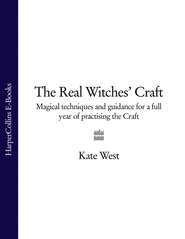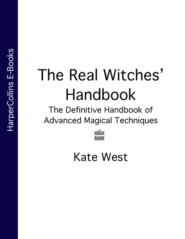По всем вопросам обращайтесь на: info@litportal.ru
(©) 2003-2024.
✖
The Real Witches’ Book of Spells and Rituals
Автор
Год написания книги
2018
Настройки чтения
Размер шрифта
Высота строк
Поля
The High Priestess then raises the Athame out of the wine and says, ‘Blessed Be’.
The High Priest then rises to his feet and, holding the chalice in both hands, offers it to the High Priestess, who also places her hands on the chalice. The High Priest then kisses her on the right then left cheek saying,
‘In perfect love and perfect trust. Blessed Be.’
She echoes his ‘Blessed Be’ and then kisses him in the same manner, using the same words. After he has echoed her ‘Blessed Be’, he releases the chalice and she takes a sip. The High Priestess then turns to her left and offers the chalice in exactly the same way to the person standing there.
It is often at this point in Ritual where some (usually men who have chosen to stand next to each other) realize that they would prefer to have alternated male and female!
Thus the chalice passes Deosil around the Circle until the High Priest has drunk from it and replaced it on the Altar.
The High Priest then takes the plate of ‘cakes’ and again kneels before the High Priestess. She takes her Athame and, drawing an invoking Pentagram over the ‘cakes’, says,
‘I bless and consecrate these cakes, symbol of the bounty of the Great Goddess. As they feed our bodies let Her love sustain us in heart, mind and spirit. Blessed Be.’
The High Priest then offers the cakes to the High Priestess in exactly the same way as he did with the wine, and she accepts in the same way, taking a biscuit. However, she does not bite into it until after she has passed the plate in the same way as before, to the person on her left, saying,
‘In Perfect Love and Perfect Trust.’
The plate thus passes Deosil around the Circle with everyone taking a ‘cake’ and only biting into it after they have passed the plate to their neighbour.
The reason for not eating before you pass the plate on is to avoid pebble-dashing your neighbour with biscuit crumbs whilst trying to kiss them and speak.
If you have less than about six people in Circle it is a good idea to let the wine return to the Altar before starting the cakes, to avoid a bottleneck. However, in a larger group, the cakes can be started after the High Priestess has passed on the wine. You need to wait until everyone has finished chewing before moving on with the next part of your Ritual.
The Rite of Wine and Cakes is sometimes confused with the Great Rite. Where the Great Rite is celebrated symbolically (as is most usual), wine is consecrated in much the same way as it is for the Rite of Wine and Cakes, but with a different focus and intent, and without the consecration of cakes. The Great Rite celebrates the physical union of the Goddess and the God, the Priest and Priestess who perform it actually become the Goddess and the God during the Ritual. In the Rite of Wine and Cakes they remain High Priestess and High Priest and invoke the blessing of the Goddess and the God.
Witches on their own can still perform the Rite of Wine and Cakes, although they will have to say (either aloud or in their head) both parts of the text and, obviously, hold both Chalice and Athame, with one hand each. The cakes can remain on the Altar when you consecrate them. It is also helpful to ensure that your Athame is on your Altar and not kept at your belt, otherwise you can run out of hands in the middle of your Rite. Instead of kissing a neighbour when saying, ‘In Perfect Love and Perfect Trust’, you can raise your glass to the Goddess and the God.
THE SABBAT, OR OTHER, BLESSING
In celebratory Rituals, Sabbats, Rites of Passage and so on, it is usual for the High Priestess, or one of the more experienced group members, to give a Blessing. This takes place after the Rite of Wine and Cakes. The Blessing should reflect the nature of the Ritual, and in the case of a Sabbat should relate that festival to the Wheel of the Year (see Appendix 2, Terms and Definitions) as a whole, in order to put it into context.
PUTTING RITES INTO RITUALS
As mentioned above there are two basic kinds of Ritual; working and celebratory. And as you will have gathered the above Rites can be incorporated into both kinds in different ways. But the following gives an idea of how these Rites are incorporated.
WORKING RITUALS – USUALLY ESBATS
DEFINE THE PURPOSE AND COMMUNICATE IT
PREPARE THE AREA
SET THE ALTAR
CREATE THE SACRED SPACE
BANISH UNWANTED INFLUENCES AND/OR SELF-BLESSING
PREPARE THE MAGIC OR SPELLS
DRAWING DOWN THE MOON
RAISING POWER
THE MAGIC OR SPELLS
THE RITE OF WINE AND CAKES
REMOVING THE SACRED SPACE
GROUNDING
TIDY AWAY
CELEBRATORY RITUALS – USUALLY SABBATS
DEFINE THE PURPOSE AND COMMUNICATE IT
PREPARE THE AREA
SET THE ALTAR
CREATE THE SACRED SPACE
INTRODUCE THE FESTIVAL
CHANTING AND DANCING, TO RAISE ENERGY FOR CELEBRATION RATHER THAN FOR WORKING MAGIC
BANISH UNWANTED INFLUENCES AND/OR SELF-BLESSING
CELEBRATE THE FESTIVAL
DRAWING DOWN THE MOON (OCCASIONALLY)
THE RITE OF WINE AND CAKES
THE SABBAT OR OTHER BLESSING
REMOVING THE SACRED SPACE
FEASTING
TIDY AWAY
Not every celebration or working will require all the above steps but those items marked
really should be performed. Although I have not marked Feasting as essential for celebrations, it would be hard to imagine a festival with no feast! Sometimes some steps will occur in a slightly different order, perhaps because you prepare the Altar before everyone arrives, or at the same time when the tidying away, grounding and writing up are done by different people.









